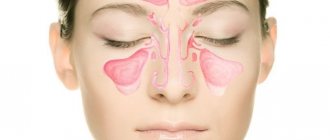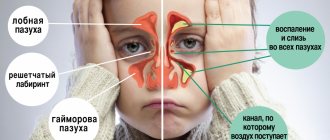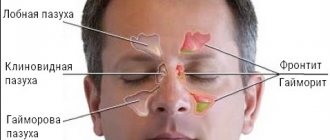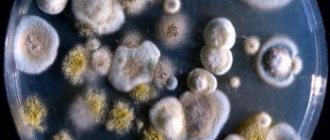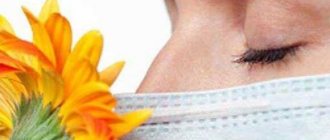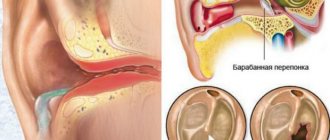How to treat at home
Even from what was stated earlier, it is clear that the factors of the disease differ, and accordingly, the course of recovery is selected individually.
But the first task of the doctor is always to “uncork” the sinus anastomosis closed by edema in order to allow the outflow of mucus and pus. At home, the treatment of sinusitis is complex; the basics of therapy are aimed at suppressing inflammation, eliminating swelling, removing mucus, and soothing the mucous membrane. Treatment at home can be carried out not only with medications, but also with folk remedies. Medical centers also use a special yamik method of treatment.
To improve the removal of inflammatory infection from the maxillary sinuses, heating is used. When treating sinusitis, heating can be dry and steam. For dry heating, you can use sea or iodized salt wrapped in cotton cloth, a boiled egg or boiled potatoes.
One of the best ways to warm up is a special blue lamp (the official name is the Minin reflector). Shining through the skin, the light from the lamp warms the sinuses, eliminates swelling and improves general condition. For successful recovery, it is recommended to carry out two to three procedures daily for 15-30 minutes.
How to properly perform a massage for sinusitis is indicated in this article.
Rinsing for sinusitis is one of the most widely used and effective procedures.
It must be carried out with caution, since water entering the middle ear under pressure can lead to the development of otitis media.
One of the most effective procedures is considered to be rinsing the nose with antiseptic and saline solutions.
Treatment of sinusitis at home in adults usually begins with rinsing the nasal cavity. Sea salt is often used for this procedure. It helps clear the sinuses of contents. Saline solution is also effective against viruses and bacteria. To prepare the solution, dissolve 1 teaspoon of sea salt in 200 ml of warm boiled water.
To prevent damage to the nasal mucosa, the salt grains must be completely dissolved in the water. The solution should not be too concentrated, as this may cause burns. It is best to let the product settle after adding salt, then drain the sediment.
To rinse the nose, you can use ready-made solutions of sea salt purchased at the pharmacy. You can also use an isotonic 0.9% sodium chloride solution for the procedure.
Furacilin is an antiseptic based on nitrofural. It is usually prescribed for the treatment of pathogenic microflora. To prepare a nasal rinse, dissolve 2 tablets of the drug in 200 ml of hot water. The resulting solution is used to rinse the nose once a day. Typically, 5 to 10 procedures are indicated. Swallowing a small amount of the solution while rinsing your nose is not dangerous.
Decoctions or infusions of medicinal herbs, in particular calendula, are often used to rinse the nose for sinusitis.
In order to prepare a decoction, pour one teaspoon of dry raw material into 250 ml of water and boil over low heat for 3-5 minutes. After the product has cooled, it is filtered. Washing is carried out 2 times a day. The procedures are indicated until complete recovery.
Nasal drops
In the complex treatment of sinusitis, nasal drops are used. The following groups of drugs are usually used:
- vasoconstrictors based on oxymetazoline, phenylephrine, xylometazoline or naphazoline. They help with nasal congestion, their duration of action is from 4 to 6 hours. The duration of use should not exceed 5 days;
- antibacterial agents and antiseptics. These drugs are effective in the treatment of pathogenic microorganisms that cause inflammation.
You can treat sinusitis at home using so-called talkers. The basis is vasoconstrictor drops (in children's dosage). You can add Dioxidin, Decasan, Prednisolone, Dexamethasone, and aloe juice to them. They are used as antimicrobial and decongestants.
Causes of purulent sinusitis
Initially, the cause of purulent sinusitis is a common runny nose. When air is inhaled, microorganisms enter, the number of which is controlled by the activity of the immune system. When the functioning of the immune system is impaired, an inflammatory process develops, leading to the formation of sinusitis.
Factors influencing the occurrence of sinusitis are:
- the formation of swelling that provokes inflammation of the mucous membranes of the nose;
- congestion of the ears and adjacent partitions, which contributes to the loss of human auditory activity;
- the appearance of stagnant processes that negatively affect the functionality of the brain and visual organs.
The cause of the disease is the transfer of pathologies: measles and scarlet fever. The development of inflammation is influenced by infections of fungal etiology. The infection process can occur in several ways. Bacteria penetrate through the aquatic environment (when swimming in bodies of water), due to non-compliance with personal hygiene rules and injury to the nose or its sinuses. The main factors that can provoke the occurrence of a pathological process include: hypothermia, an insufficiently strong immune system and allergic reactions.
What causes the disease to develop?
The following reasons can lead to the appearance of purulent sinusitis:
- chronic runny nose, which is aggravated by the addition of a bacterial infection;
- chronic source of inflammation in the body;
- deviated nasal septum;
- allergies that lead to the development of swelling.
However, in order for a bacterial infection to continue to develop in the body, it must have a favorable environment, which is:
- decreased immunity;
- regular runny nose;
- lack of correct and timely treatment of viral or bacterial infections;
- disturbance of psycho-emotional state.
Often purulent sinusitis is the result of an acute respiratory viral infection
Acute purulent sinusitis can be eliminated much easier if you know the true reasons for its development, in addition, this will help prevent the inflammatory process from becoming chronic.
Now let's talk about the characteristic signs of the development of the disease.
Treatment methods
When treating purulent sinusitis, it is necessary to eliminate pus from the maxillary sinus and stop its further formation.
Non-drug treatment
A good result is obtained by washing the paranasal sinuses using the “cuckoo” method. Using a special device, a solution containing antiseptics is injected into the cavities and cleanses them of pus.
When treating purulent sinusitis, they also resort to another effective, puncture-free method of cleansing the sinuses - the YAMIK sinus catheter method. The method is used for both therapeutic and diagnostic purposes.
The YAMIK catheter allows you to simultaneously rinse all paranasal sinuses with aseptic solutions, without resorting to puncture of the maxillary cavity. The puncture is prescribed according to indications for chronic purulent sinusitis.
When puncturing the maxillary cavity, it is possible to completely clear the pus and treat the mucous membrane with medications. In the treatment of purulent sinusitis in children, puncture is used after 6 years.
Puncture is prescribed for children with frequent relapses of purulent sinusitis. The puncture is done through the nasal passage under local anesthesia.
The patient does not experience any pain, only discomfort from the internal sensation when the bone wall of the sinus is pierced.
A timely puncture, in combination with antibiotic treatment, usually cures purulent sinusitis and prevents the transition to a chronic form and the occurrence of complications.
Physiotherapy is effective in the treatment of purulent sinusitis. The patient undergoes laser therapy sessions, treats the sinuses with ultraviolet irradiation, and undergoes a course of microwave and solux.
Drug treatment
Chronic and acute purulent sinusitis is treated with antibiotics.
The patient is immediately prescribed a broad-spectrum antibiotic, most often amoxiclav or amoxicillin. Antibiotics of the cephalosporin group and macrolides are also used. The drugs are taken for a course of up to 10 days; if addiction occurs and there is no result, the antibiotic is replaced.
For treatment, local antibiotics are used in the form of isofra, bioparox, and polydex sprays. Inflammation and swelling of the mucous membrane are reduced with vasoconstrictor drops, Nazivin, Otrivin, Rhinonorm sprays.
At home, the nose is washed with Dolphin and Miramistin, saline solution, Aqualor, Furacilin. To liquefy the purulent contents of the sinuses, ACC (an analogue of the drug Fluimucil) is used. If there is an allergic component, antihistamines are used - suprastin, tavegil.
For purulent sinusitis and rhinitis in children, the drug Dioxidin is also used.
The intensity of pain during purulent sinusitis is reduced with anti-inflammatory painkillers; Nurofen, analgin, and baralgin are prescribed.
Treatment
Sinusitis of a purulent nature is treated in several ways.
Therapeutic rinses
The greatest effect in the process of getting rid of inflammation of the maxillary sinuses can be achieved through regular rinsing.
The procedure is performed using warm antiseptic solutions. Furacilin or ectericide are perfect for washing.
Sprays and nasal drops with antibacterial effect
Local antibiotic treatment is prescribed in almost every case. When using these remedies, therapy is easier and recovery occurs faster.
The most famous representatives of nasal preparations are Bioparox and Isofra. They can only be used with the permission of the attending physician.
Physiotherapeutic procedures
All patients suffering from sinusitis must undergo a course of physiotherapy, in parallel with other types of treatment. You may be prescribed heating, electrophoresis, and exposure to ultraviolet light.
If you carry out these manipulations in combination with “cuckoo” washing, you can get simply stunning results. If there is no effect, the patient has one or both sinuses pierced.
Traditional medicine methods
Any specialist in the field of otolaryngology will say that getting rid of sinusitis without adequate drug therapy is not possible. Inept treatment at home can only worsen the current situation.
The inflammatory process can spread to other sinuses, as well as affect the throat or respiratory organs. However, properly dosed traditional medicine under the supervision of a doctor is an excellent basis for basic therapy.
Many natural tinctures, plant extracts, as well as self-made ointments and creams have been confirming their effectiveness for a long time. In this way, people were able to successfully fight various diseases until antibiotics appeared in medicine. This includes treating sinusitis at home.
After consulting with your doctor, you can start treating sinusitis with folk remedies:
- Rinsing the nasal canals and maxillary sinuses with tincture of chamomile and St. John's wort in equal proportions - the escaping masses will allow you to breathe freely for some time.
- Ear turundas soaked in the medicine. You will need a small amount of vodka, bee honey, the juice of one onion, as well as any oil (vegetable or olive). All ingredients are mixed together and brought to a boil over low heat. As a result, you will receive natural nasal drops. Treatment should be continued for up to 10 days inclusive.
- Place a few drops of aloe mixed with liquid honey into the nose. 3 drops for each nasal opening will be enough.
Please note that when treating purulent sinusitis at home, it is not advisable to use sprays. Only drugs in the form of drops are suitable. In addition, you need to be able to bury your nose correctly:
- The patient lies on his left side and makes instillations into the left nasal passage;
- You need to remain in this position for 5–7 minutes;
- The same manipulations should be repeated for the right side;
Herbal nasal drops, which you can prepare yourself, constrict blood vessels and have a disinfecting and softening effect.
Interesting moment! Some patients note that treatment of purulent sinusitis with folk remedies worked better and faster for them than traditional treatment with medications.
Getting rid of sinusitis in this way will take longer, but also be less traumatic for the body. Non-traditional methods can also quickly relieve symptoms and treatment with drugs will be easier.
Is puncture necessary for purulent sinusitis?
As statistics show, most often treatment of purulent sinusitis ends with a puncture or puncture of the nasal sinuses. Many people are interested in how mandatory the procedure is and is it possible to get rid of sinusitis without a puncture?
It is safe to say that in a number of situations a puncture is indeed necessary. This often happens when a patient seeks help with advanced sinusitis (purulent processes develop intensively). If the maxillary sinuses are filled with secretions, the risk of complications increases rapidly.
A puncture is resorted to when the doctor does not consider it advisable to wait for results from drainage, rinsing or drug therapy.
The patient has critically little time to wait. The main danger of a purulent process in the nose that is not cured in time is the likelihood of developing sepsis and the movement of pathogenic masses to the brain area.
In this case, a puncture is one of the ways to quickly and effectively wash out all the excess secretion from the sinuses (it immediately comes out). Treating the canals with antiseptic solutions will prevent the infection from moving further and affecting healthy tissue.
However, puncture should not be considered an absolute panacea. In certain situations it is quite possible to do without it. There are many other ways to cure purulent sinusitis.
Methods of treating the disease
Therapy is prescribed depending on the stage and development of the pathology. If the disease is mild to moderate, medications are used. At a more severe stage, specialists resort to surgery.
It is worth paying attention: many otolaryngologists claim that for the best effect in the fight against pathology, it is advisable to use traditional medicine together with medications
Drug treatment
As practice has shown, the initial stage of purulent sinusitis responds well to complex treatment. The combination of drugs will reduce pain and signs of the disease.
The complex treatment method includes:
- Vasoconstrictor drops. These symptomatic remedies will help cure runny nose and nasal congestion.
- Antifungal drugs. Medicines in this category suppress and destroy fungal microorganisms.
- Vitamins. The fortified complex helps strengthen the immune system.
- Antibiotics. These drugs will help relieve the inflammatory process.
- Antipyretic drugs. With their help, high body temperature is reduced and overall well-being improves.
After purulent secretions begin to leave the nasal sinuses and the disease stops progressing, physiotherapeutic procedures are prescribed.
Surgical intervention
Surgery is prescribed only in cases where the disease becomes severe or the disease is not amenable to drug treatment. These procedures are quite painful, so they are performed under general anesthesia.
Surgical intervention is carried out in the following ways:
- Puncture. This procedure is prescribed when the maxillary sinusitis is heavily clogged with pus, but the mucus does not come out of the nose. To clear the sinuses, the thin walls of the nose are pierced with a sharp needle. Through the punched holes, the nasal cavity is cleansed independently. After this method, breathing improves and the inflammatory process in the body subsides.
- YAMIK catheter. Despite the fact that this is a common technique, not everyone knows how to treat sinusitis with its help. Therefore, this procedure is carried out only by qualified specialists. To carry it out, a rubber catheter with two balloons is used. Having introduced them into the nasal cavity, they begin to expand in volume. After this, using a syringe, the pus is sucked out of the nasal sinuses. The peculiarity of this method is that after its use, people suffering from chronic sinusitis quickly recover.
Regardless of the method, after surgery, the patient is placed in a hospital to monitor his well-being.
So, having learned the symptoms and treatment in adults, you can independently conclude that purulent sinusitis is a rather dangerous, but still treatable disease. The final result of therapy will depend on the stage of the pathology. Therefore, at the first signs of rhinitis, you should immediately consult a specialist.
Complications and consequences
Left-sided purulent sinusitis, or the accumulation of pus in the sinus on the other hand, is a dangerous disease that, even during treatment, can provoke the development of the following severe complications:
- bacterial infection in the roots of the upper teeth, their destruction or complete loss;
- inflammation of the bone tissue of the facial disc, the beginning of the process of acute osteomyelitis, which inevitably ends in death or surgery to remove a bone fragment with further prosthetics;
- entry of pus into the cavity of the skull, after which after 2 days the patient begins to experience symptoms of a secondary disease called meningitis or bacterial encephalitis;
- decreased quality of vision and hearing loss if bacterial microorganisms present in the maxillary sinuses, along with pus, enter these organs;
- critical depletion of the immune system, the body's vulnerability to even the most harmless infections.
The most dangerous negative consequence of purulent sinusitis is septic blood poisoning and death.
Even if the patient managed to avoid death, he remains disabled for the rest of his life due to damage to one or another vital organ that has undergone purulent-bacterial invasion
Causes of pathology
In healthy people, the nasal sinuses contain a certain amount of pathogenic microorganisms that we inhale along with the air. During normal functioning of the immune system, their number is strictly controlled.
The reverse reaction occurs when immunity decreases. The maxillary sinuses become inflamed, and external (exogenous) microbes interact with internal (endogenous) microorganisms. If the immune system is weakened and cannot cope with its protective function, then sinusitis develops in the body.
If you do not pay attention to it in a timely manner, it can develop into a chronic acute form of purulent sinusitis.
Sinusitis manifests itself in the following forms:
- Swelling appears in the maxillary sinuses, causing the nasal mucosa to become inflamed.
- As a result of congestion in the nose and adjacent partitions, the ears become blocked, and a person may temporarily lose hearing.
- Stagnant processes form in the maxillary sinuses, which directly affect the brain and eyes.
- A weakened immune system aggravates the disease; gradually, mucus from the sinuses moves inward and turns into pus.
A decrease in immunity can occur due to a person suffering from colds such as scarlet fever or measles. The causes of these diseases are of a very similar infectious nature.
Causes of pathology
Before prescribing effective treatment, it is necessary to determine the causes of the pathological process. If this is not done, then the pathogenic factor will continue to interfere with the patient’s normal life, and he will not be able to recover quickly. Obviously, the disease is caused by increased activity of microbes that penetrate the nasal passages and maxillary sinuses. It could be staphylococcus, streptococcus, or other protozoa.
Sinusitis of purulent form is a complication of a cold or acute respiratory viral infection, and the first relapse is preceded by provoking factors in the body, which is still weakened by the disease. Among these are:
- Allergic rhinitis, untreated for a long time.
- Anatomical features of the nose, for example congenital or acquired curvature of the nasal septum.
- Infection with microbes in progressive rhinitis.
- Periodontitis, deep caries, other dental diseases.
- Adenoids, polyps, other neoplasms in the nasal passages;
- Weakening of the protective functions of the nasal mucosa.
- Prolonged hypothermia of the body.
Sinusitis can be unilateral or bilateral, and in the second clinical picture, to facilitate nasal breathing, identifying and eliminating the pathogenic factor is not enough; a puncture is also required - a puncture of the pathology focus with further removal of purulent masses. If the doctor manages to determine the cause of the disease clinically, this means that the patient’s chances of a speedy recovery are doubled.
How to identify and treat odontogenic sinusitis?
Odontogenic sinusitis is not the most common disease, but still not rare. How to identify such a disease and avoid the consequences? How is the treatment carried out?
What kind of disease is this?
In general, sinusitis is an inflammation of the maxillary paranasal (maxillary) sinuses. And the definition of “odontogenic” refers to the causes of this very inflammation. It is connected with teeth. Yes, the outermost teeth (molars) communicate through the jaw with the maxillary sinuses, so infections can easily come from them.
Causes
It has already become clear that inflammation in the disease in question spreads into the maxillary sinuses from the dental tissues. But the specific causes of this inflammation can be very diverse:
- Advanced caries. This disease can lead to decay of the dental nerve and provoke decay, which will spread through the sinus membrane and into it.
- Osteomyelitis of the upper jaw.
- Perforation of the maxillary cavity. Through the hole, the contents of the oral cavity can enter the maxillary sinus, causing inflammation and rotting.
- Periodontitis of molars (first and second, as well as premolar).
- Burst or festering cysts located in the upper jaw.
- Foreign bodies that have entered the maxillary sinus from the jaw. These could be fragments of a tooth root remaining in the jaw after incorrect or incomplete removal, or particles of a filling.
Manifestations
How does odontogenic sinusitis manifest itself? The symptoms of this disease are:
- Nasal congestion (usually on one side), impaired nasal breathing.
- Nasal discharge. They may be transparent and not abundant, but with purulent inflammation they will become thick, acquire a greenish or yellowish tint and an unpleasant odor. In rare cases, the mucus may contain food debris that has entered the sinus from the oral cavity through an opening in the jaw.
- There is discomfort in the forehead, eye socket or root of the nose (most often on one side), pressure and bloating occur. Unpleasant sensations can develop into pain, which intensifies when you press on the area of inflammation, when you blink or make facial expressions. Pain can spread to the jaw, temples, and forehead.
- Acute odontogenic sinusitis is usually accompanied by symptoms such as general malaise, fever and chills.
- Sometimes the sense of smell may be impaired (often patients do not notice this, because only one sinus is affected).
- The timbre of your voice may change.
In the chronic course of the disease, symptoms may be vague and appear only during periods of exacerbation (for example, after a cold).
X-ray for odontogenic sinusitis
Diagnostics
To begin treatment, you need to make a diagnosis and, equally important, find out the causes of the disease. The most informative diagnostic procedure is an x-ray examination
Endoscopy may also be prescribed.
How to treat?
Treatment of a disease such as odontogenic sinusitis will be aimed at eliminating its causes, that is, at identifying and sanitizing the source of inflammation.
- If the cause of inflammation is caries, then the affected tooth will most likely be removed, because if the infection has spread to the maxillary sinus, this means that the nerve and root have been destroyed. This means that it will not be possible to save the tooth.
- Rinse of the maxillary sinus may be necessary. But it can only be carried out if there are no foreign bodies in the sinus cavity. Washing is carried out on an outpatient basis by moving fluids (“cuckoo”) or by changing pressure (using a special YAMIK catheter). It is better not to carry out the procedure at home.
Sumamed is a fairly commonly used antibiotic.
Remember that odontogenic sinusitis is dangerous! Contact your doctor promptly if you have any warning signs.
Clinical picture
So, what does the disease look like and what symptoms are characteristic of it? As mentioned above, the disease can occur in two forms:
- acute process;
- chronic form.
Symptoms of an acute process are distinguished by their suddenness, as well as their rapid and rapid development. As for the symptoms of the chronic form, they are sluggish and their intensity is less pronounced.
First, let's talk about the symptoms of acute inflammation:
- increased body temperature;
- chills;
- headache, which is localized in the frontal part of the head and is very severe;
- the nose is stuffy and severe swelling of the mucous membrane appears;
- swelling of the eyelids;
- swelling in the bridge of the nose;
- when palpating the area of the maxillary sinuses, painful sensations occur;
- purulent or mucopurulent discharge appears from the nose. Sometimes the discharge may contain blood;
- When tilting the head or clenching the teeth, an increase in headache occurs, as well as a feeling of squeezing in the bridge of the nose.
With sinusitis, nasal congestion and swelling are so severe that patients breathe only through their mouths
As for the chronic form, the clinical picture is somewhat different:
- malaise, lethargy, apathy, weakness;
- constant pressing headache of moderate nature;
- painful sensations in the teeth;
- constant nasal congestion with impaired nasal breathing;
- during the period of exacerbation of the process, copious nasal discharge of a mucous or mucopurulent nature appears.
Mostly what color is the snot? Nasal discharge is often difficult to clear and is usually brown or yellow-green in color. Non-purulent sinusitis is not accompanied by the appearance of this kind of discharge.
Now let's move on to the question of what kind of treatment for purulent sinusitis.
Treatment of purulent sinusitis of acute and chronic forms
Therapy for acute purulent sinusitis, as well as its chronic type of disease, consists of a complex of medications that have an antibacterial and anti-inflammatory effect, namely.
Antibiotics
For purulent sinusitis, the antibiotic is selected individually based on which strain of bacterial microflora caused the accumulation of pathogenic exudate inside the maxillary sinuses. Without taking this factor into account, it is impossible to achieve a positive therapeutic result. Most often, doctors prescribe drugs such as: Azithromycin, Erythromycin, Amoxilav, Augmentin, Sumamed, Biseptol, Bicillin. They are introduced into the patient’s body, both in the form of tablets and as intramuscular injections. Typically, the duration of treatment with antibacterial medications lasts from 10 to 15 days and depends on the severity of the disease.
Folk remedies
An alternative form of medicine offers its own alternative methods of combating purulent sinusitis, with the help of which it is quite possible to cure this disease. They look like this:
- you need to take one leaf of Kalanchoe or aloe, grind it in a meat grinder and squeeze out the juice from it (the pulp is eaten as a general anti-inflammatory agent and stimulates the activity of cells of the immune system, and the resulting juice is dropped into the nose 2 times a day for 5 days as antibacterial drops);
- washing the maxillary sinuses with an antiseptic solution (dissolve 1 teaspoon of salt or 2 crystals of potassium permanganate in 1 liter of water, draw the solution into a 20 ml disposable syringe and inject the liquid into each nasal canal in turn, and then blow your nose so that purulent exudate is washed out along with the antiseptic );
- acupressure of the paranasal sinuses, which is based on massaging the surface of the face in the area of the wings of the nose, with circular movements (local blood circulation improves, the secretory function of the mucous membrane increases, which has a positive effect on the independent outflow of purulent discharge).
Surgery
Puncture of purulent sinusitis is one of the methods of treating this disease if the pus does not come out, and the use of traditional drug therapy has not brought positive results. The surgeon uses a special needle to pierce the maxillary sinus and install a drainage system through which pus flows outside the sinuses after puncturing the sinus. The procedure is painful, so it is performed under local anesthesia. At the patient's request, general anesthesia may be used. The rehabilitation period takes from 3 to 7 days and largely depends on the individual characteristics of the patient’s body.
Purulent sinusitis: Treatment of the disease
In the case of an acute course of the disease, it is not enough to just use antibiotics, since it is necessary to comprehensively treat purulent sinusitis. Since therapy must be aimed at activating the body’s protective functions and eliminating inflammation. Therefore, it is necessary to combine the effects of restorative, physiotherapeutic and medicinal methods.
The treatment regimen for sinusitis will depend on various factors:
- severity of the disease;
- causes of illness;
- anatomical features of the structure of the nose;
- general condition of the patient.
Treatment with medication
To reduce swelling of the nasal mucosa, vasoconstrictors are required. Tampons soaked in these medications should be used to close the nasal passages for a few minutes. And when inflammation of the maxillary sinuses occurs as a result of allergies, antihistamines are prescribed for treatment, relieving the symptoms of an allergic reaction.
Often the cause of sinusitis is pathogenic microorganisms . Therefore, antibiotics are used in conservative treatment. But it should be noted that a very long or, conversely, short-term course of treatment can only aggravate the situation - this is how purulent bilateral sinusitis appears.
If you use medications for only 3-4 days, then the likelihood of a relapse of the disease is quite high. And with prolonged treatment, pathogenic organisms become resistant to antibiotics.
Also quite often used are various sprays for sinusitis containing corticosteroids - substances that stop the process of inflammation of the nasal mucosa and increase the defense of the immune system. These remedies are used only if the symptoms of the disease persist for more than a month and other treatment methods are ineffective. Corticosteroids are also prescribed for nasal polyps or severe swelling of the nasal mucosa.
Physiotherapeutic treatment
For faster results, various physical procedures are often used simultaneously with traditional medicine. Laser therapy, UHF, and heating are possible.
The simplest option for warming up the maxillary sinuses is a poultice. To do this, place a dry towel on a napkin soaked in warm water and apply a heating pad on top. For the proper effect, this procedure must be performed for 20 minutes twice a day. After this, you are prohibited from leaving the premises for about an hour.
In addition, in medicine, relatively recently, a method such as pulsation heat treatment . Traditionally, a regular hairdryer is used to perform this, which must be held at arm's length. During inhalation, you need to direct warm air to the nose area, and when exhaling, remove it. The duration of the process is half an hour. But heating should be stopped if pain increases.
Sinusitis: symptoms
Symptoms of sinusitis in adults and children can be quite varied and they do not always clearly indicate that inflammation has begun in the maxillary sinuses. If we talk about sinusitis (symptoms), then a lot depends on the form and stage of the disease.
Let's look at the signs and symptoms of acute sinusitis.
In acute sinusitis, the patient feels a severe headache, a feeling of pressure in the sinuses, pressing pain in the cheekbones, forehead, and temples. In this case, the pain can affect the entire face or one half of it (with a unilateral process). Another symptom of acute sinusitis is toothache, which gets worse when eating. In people suffering from sinusitis, nasal breathing is severely impaired and characteristic nasal discharge occurs.
The main symptoms of sinusitis in adults:
- Headache. One of the most common symptoms of sinusitis. This is due to the accumulation of pus in the inflamed sinuses. Pain in the head may weaken or go away at night, while lying down, which is associated with the release of pus from the sinus. The pain in the nose area gradually becomes stronger and stronger. In the morning they are not as pronounced as in the evening. Gradually, the pain ceases to be local and spreads to the entire surface of the head.
- Difficulty in nasal breathing. The patient's nose becomes stuffy, it becomes difficult to breathe, and the voice becomes nasal. Usually both halves of the nose are blocked, but from time to time there may be weakening on the right and left sides.
- Nasal discharge. Almost all patients experience clear, mucous or purulent (yellow, green) discharge from the nose. If the nose is very stuffy, then this symptom may not occur.
- Fever. This symptom is more typical of acute sinusitis. In the chronic form, body temperature rarely rises.
- General malaise. This symptom is expressed by weakness, fatigue, apathy, appetite and sleep disturbances.
- Decreased sense of smell, photophobia, increased lacrimation. These symptoms do not occur in all patients.
In acute respiratory infections, the symptoms of sinusitis are superimposed on the symptoms of a respiratory disease that directly affects the development of sinusitis. The first signs in this case are chills, fever, runny nose, sneezing, nasal congestion, and general malaise. After a short time, the main symptoms are joined by pain in the face, radiating to the forehead, teeth, and bridge of the nose. The pain may worsen with pressure on the area under the eyes. In some cases, redness and swelling of the eyelids are observed. Acute sinusitis goes away after 2-3 weeks.
Sinusitis: symptoms in children
In acute sinusitis, the following symptoms are observed: lethargy, general weakness, sleep and appetite disturbances, moodiness, headaches, increased body temperature, profuse nasal discharge, swelling of the eyelids, deterioration of the sense of smell.
With sinusitis in children, bilateral involvement is more common. Parents should be extremely attentive and careful if they suspect sinusitis. The child may not tell you exactly what hurts him. You should not self-medicate or rely on the best. You should immediately consult an otolaryngologist (ENT).
Symptoms of chronic sinusitis
Symptoms of chronic sinusitis can be invisible or mild, which often misleads patients. The main symptom of chronic sinusitis is a constant runny nose that cannot be treated with traditional methods. Patients also complain of pain in the depths of the eye sockets, headaches, conjunctivitis, and swelling of the eyelids.
Chronic sinusitis is accompanied by periodically flaring dull pain in the eye area, frequent nasal congestion, and headaches (which go away when lying down). Another important symptom is a chronic cough that does not go away when treated with expectorants and antitussives. The cough appears due to pus flowing down the wall of the throat.
Symptoms of purulent sinusitis
The main symptoms of purulent sinusitis are purulent discharge, which can be felt on the pharyngeal wall, and crusts that form on the nasal mucosa. This discharge differs from a regular runny nose in its thickness and unpleasant, pungent odor.
Other symptoms of acute sinusitis:
- discomfort in the sinus area;
- pressing headache;
- impaired breathing and nasal voice;
- increased body temperature;
- symptoms of general malaise (fatigue, weakness, loss of appetite, sleep disturbances);
Symptoms of the chronic form may not appear as clearly. There is no temperature, the headache appears and disappears haphazardly, which is why it is often attributed to something else. But there is always a runny nose and cough, which cannot be cured by any medicine.
How to cure a disease using traditional methods
Treating sinusitis at home using alternative medicine recipes can only be done with the permission of the attending physician. And it should be used as an additional treatment to the main therapy prescribed by the otolaryngologist.
Treatment at home with folk recipes:
Washing
One of the simplest, but at the same time effective remedies for sinusitis is rinsing. For this procedure you will need medicinal herbs (for example, it could be chamomile, sage or thyme) and 250 ml of filtered water. Pour water over the herbs and put on fire. Bring the broth to a boil, then reduce the heat and continue to simmer for another 10 minutes. Remove from heat and leave to steep for 10 minutes. Strain the broth through cheesecloth and wait until it cools to room temperature. Before washing the maxillary sinuses, you need to make sure that the temperature of the decoction is comfortable for the mucous membrane.
But before starting rinsing, it is advisable to make sure that the patient is not allergic to any of the herbs.
For rinsing, you can use regular salt or sea salt without additives. Dilute 1 tbsp. l. in a glass of warm water and rinse your sinuses once a day.
Inhalations
Various inhalations are also very effective in treating pathology. To prepare, you need to take 300 ml of water, eucalyptus essential oil or fir oil. Heat the water a little and add 3 drops of essential oil. Cover with a towel and breathe in the steam for 20 minutes. Inhalations can also be carried out with decoctions of medicinal herbs.
Onion
To get rid of nasal congestion, you can use onions. You need to take one fresh onion and grate it on a fine grater. Take several breaths over the bow through each nostril. If a burning sensation or other unpleasant sensations appear, then this procedure will have to be abandoned.
Aloe juice
Aloe juice is often used to treat most pathologies of the nasal mucosa. Cut a fresh aloe leaf and wait until a small amount of clear liquid comes out in the cut area. Take the juice into a pipette and drop 3 drops into each nostril several times a day.
But any procedures must be coordinated with your doctor. If he does not allow you to rinse your nose or use any other alternative medicine recipes, then you should listen to him.

